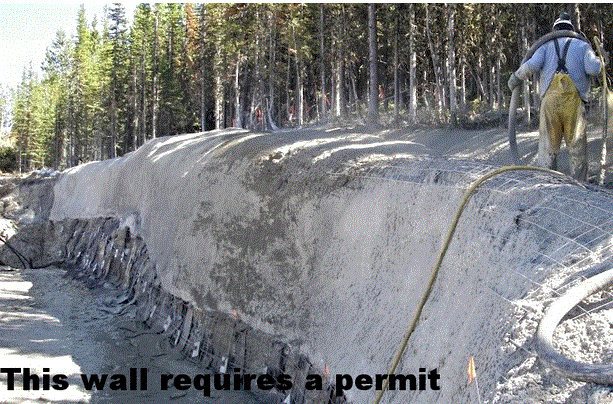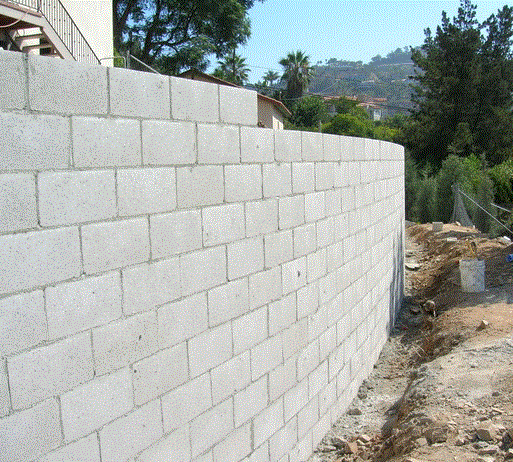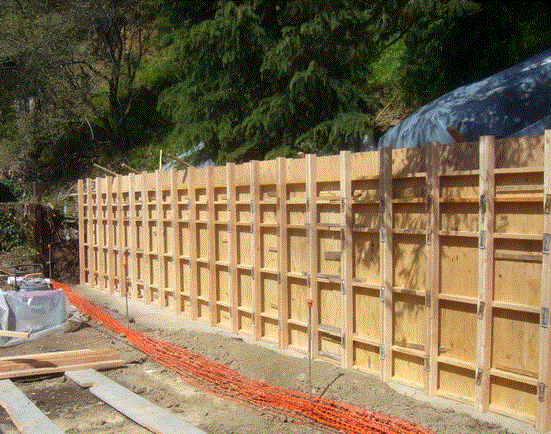Retaining Walls & Definitions
A retaining wall is a wall designed to resist lateral earth and/or fluid pressures, including any surcharge, in accordance with accepted engineering practice. This definition also applies to freestanding pool walls.
The Folsom Municipal Code adopts, by reference, the 1997 Uniform Building Code (UBC). UBC §106.2, item 5 states that: “A building permit shall not be required for … retaining walls that are not over 4 feet in height measured from the bottom of the footing to the top of the wall, unless supporting a surcharge …”
It is a common misconception by builders, designers, landscape contractors, pool contractors and homeowners that this section of the UBC allows retaining walls of up to 4 feet in exposed wall height to be constructed without a permit, regardless of the back slope conditions.
In order to interpret this building code section correctly, a clear understanding of the following terms is essential:
• Retained Wall Height is the vertical distance measured from the bottom of the footing to the finish grade at the top of the wall (i.e. upper soil grade). This is the height referred to in UBC §106.2, item 5 and it includes the wall and depth of footing below grade.
All These walls above require Building permits
• Exposed Wall Height is the vertical distance measured from the finish grade at the bottom of the wall (i.e. lower soil grade) to the finish grade at the top of the wall (i.e. upper soil grade). This height does not include the wall and depth of footing below grade.
• Surcharge is a vertical load imposed on the retained soil that may impose a lateral force in addition to the lateral earth pressure of the retained soil.
Examples of surcharges are:
• Sloping retained soil
• Structure footings supported by the retained soil
• Adjacent vehicle loads supported by the retained soil Solid fences that are attached (or directly adjacent) to a retaining wall also impose additional lateral forces on a retaining wall when wind pressures act on the fence.
Definitions:
Cantilever Retaining Wall:
Typically constructed of reinforced concrete masonry units or reinforced concrete stem wall supported on a reinforced concrete footing.
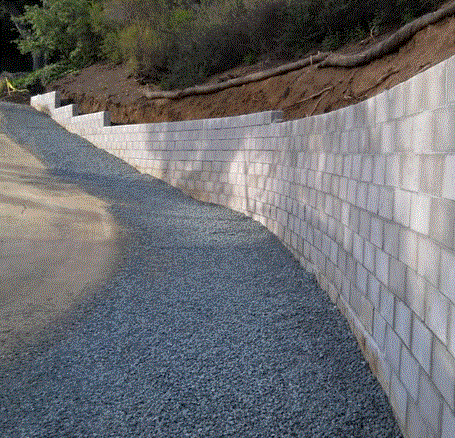
Tie Back Retainer Wall:
An anchored retaining wall can be constructed in any of the styles but also includes additional strength using cables or Helical tie backs with other types of rods anchored in the rock or soil behind it. Usually driven into the material with boring, or rotation and drilling anchors are then expanded at the end of the cable, either by mechanical means or often by injecting cement, which expands to form a bulb in the soil.
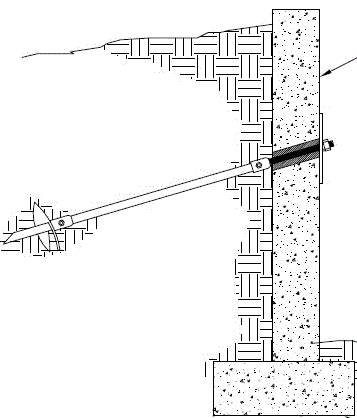
Segmental Gravity Wall:
Typically constructed of manufactured (i.e. Allan Block, Earth stone, Keystone, etc.) modular concrete units stacked in a running bond pattern without mortar or reinforcement.
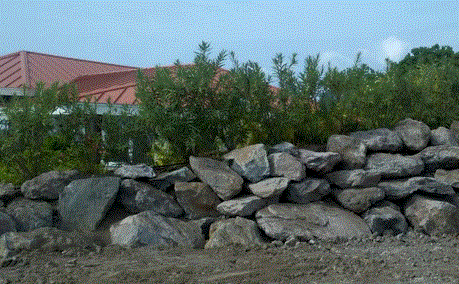
Sheet pile Retaining walls:
Sheets of steel are driven pneumatically in to soft soil in the tight access or flood zones to create an area of excavation, Its Usually deigned by a Structural Engineers, some times including tie backs.
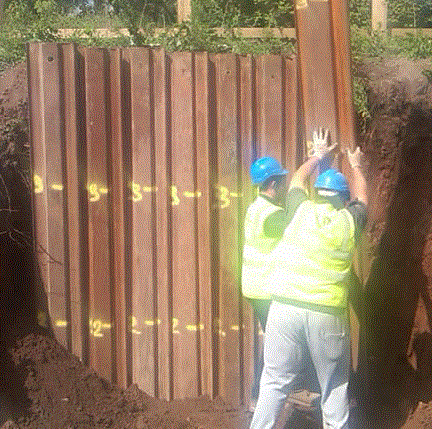
Soldier Pile Retaining walls:
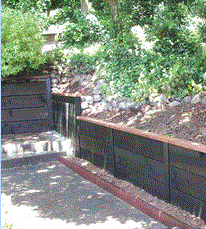
Soldier piles retains soil, using vertical steel piles or wooden posts with horizontal lagging. Typically, H-piles are drilled or driven at regular intervals along the planned excavation perimeter, cast in to concrete pier hole. Lagging consisting of wood, steel or precast concrete panels is inserted behind the front pile flanges as the excavation proceeds. The lagging effectively resists the load of the retained soil and transfers it to the piles. The walls can be designed as cantilever walls, or receive additional lateral support from anchors or bracing. The technique has been used to provide support for many excavations or simply a garden wall.
A typical cantilever reinforced masonry (or concrete) retaining wall will utilize a footing with a thickness of at least 12 inches. Based on this minimum footing thickness, a retaining wall with a maximum retained wall height of 4 feet would correspond to maximum exposed wall height of 3 feet.
Contractors and homeowners are usually more aware of the vertical offset between the upper and lower grade elevations that will be required for the retaining wall. This is simply the exposed wall height and it is for this reason that the Planning, Inspections and Permitting Department interprets UBC §106.2, item 5 as follows: “A building permit shall not be required for … retaining walls that are not over 3 feet in exposed wall height unless supporting a surcharge …”
Building Permit Requirements
A building permit is NOT required for:
• Cantilever or segmental gravity retaining walls with an exposed wall height of three feet or less, where the retained soil does not support a surcharge (i.e. level backfill only) and the wall does not support a solid fence.
• Wood retaining walls (with or without a fence) with an exposed wall height of two feet or less, where the retained soil does not support a surcharge (i.e. level backfill only). All wood retaining walls shall be constructed entirely of treated wood and conform to standard drawing LS-43.
All other retaining wall conditions such as taller walls, tiered walls, and/or walls supporting sloping backfill (or other surcharges) will generally require a building permit.
When a Building Permit is Required for Retaining wall?
A building permit can usually be issued over the counter when two copies of the following are provided along with a completed permit application:
- Plot Plan showing the location, extent, and height of the retaining wall in relation to any building structure, pool, property lines and public utility easements.
- Detail(s) showing complete construction details of the retaining wall. Detail(s) are to be wet stamped and signed by a California registered civil or structural engineer. For segmental gravity retaining walls, the detail(s) must clearly identify the block manufacturer; block type, drainage requirements, and maximum wall height.
- Structural Calculations wet stamped and signed by a California registered civil or structural engineer (or standardized engineering calculations and ICBO Evaluation Report for applicable segmental gravity retaining walls).
Segmental Gravity Walls
Segmental gravity retaining walls such as Keystone, Allan Block, etc. are frequently available from local building supply warehouse stores. Regardless of the permit requirements, it is important to follow the manufacturer’s recommendations for each block type since the allowable wall heights vary significantly for each block type. For example, Keystone limits their Garden Wall (4” high x 12” wide x 9” deep) product to 2 feet in height … or six blocks in height total. The Keystone Legacy Block (6” high x 16” wide x 10½” deep) product is limited to 3 feet in height … or six blocks in height total. Neither of these block types is recommended when the retaining wall is supporting a sloping backfill, any other surcharge or a solid fence.
Tiered Retaining Walls
Use of tiered walls is a special condition where two or more short walls, horizontally offset from one another, are used in lieu of a single tall retaining wall. When tiered walls are not properly offset from each other, the upper wall may impose a surcharge condition on the lower wall. In order for the walls to be treated as separate retaining walls, a general rule of thumb is that the tiered walls be horizontally offset by a minimum distance of two times the exposed wall height of the lower wall.
As an example, two tiered retaining walls each with an exposed wall height of 3 feet, and level back fill that are horizontally offset by a distance of 2 feet would be treated as a single 6 foot tall wall and as a result, a building permit would be required.
Any Questions?
Should you have any questions, please stop by the public counter of the Building permit section of the City Hall
If you are looking for a contractor in the San Francisco bay area to construct your retaining wall, be sure to contact Montclair Construction. If you have any questions or want an estimate don’t hesitate to contact us.
